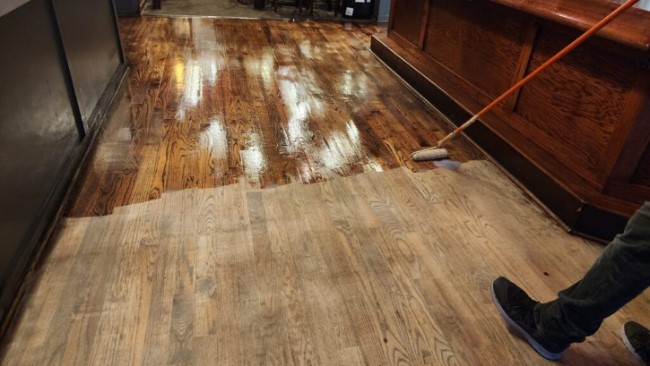Screen & Recoat vs. Sanding: Exploring the Differences and Benefits
Maintaining the beauty and longevity of hardwood floors is a priority for many homeowners. Over time, wear and tear can take a toll on the surface of your hardwood floors, leaving them looking dull and scratched. When it comes to refreshing the appearance of your floors, two common options are often considered: screen and recoat, and sanding. In this blog post, we’ll delve into the differences between these two methods and explore the unique benefits each brings to the table.
Understanding Screen & Recoat:

Screen and recoat is a less invasive method of refreshing hardwood floors compared to sanding. This process involves lightly abrading the existing finish on the floor using a screening pad or mesh screen, followed by the application of a new coat of finish. The goal is to create a smooth surface and revive the luster of the existing finish without removing a significant amount of wood.
Benefits of Screen & Recoat:
- Cost-Effectiveness: One of the primary advantages of screen and recoat is its cost-effectiveness. This method is generally more affordable than sanding because it requires fewer materials and less labor. It’s an excellent option for homeowners on a budget who want to enhance the appearance of their floors without a complete refinishing process.
- Time Efficiency: Screen and recoat projects typically take less time to complete compared to sanding. Since there’s no need to remove a substantial amount of wood, the process is quicker, allowing homeowners to enjoy their refreshed floors sooner.
- Less Disruption: Screen and recoat is a less disruptive process for homeowners. There is minimal dust and odor, making it a more convenient option for those who want to avoid the inconvenience of a full sanding project.
Understanding Sanding:

Sanding involves the removal of the existing finish and a thin layer of wood from the hardwood floor. This process is more intensive than screen and recoat and is typically recommended when there are deep scratches, gouges, or other severe damage to the floor.
Benefits of Sanding:
- Restoration of Severely Damaged Floors: Sanding is the preferred method when the existing finish is severely damaged, or there are deep scratches and gouges that cannot be addressed with a screen and recoat. It provides a fresh start by removing a layer of wood, allowing for a new, even finish.
- Customization Options: Sanding provides an opportunity to change the color of your hardwood floors or apply a different type of finish. This flexibility allows homeowners to customize their floors according to their preferences.
- Long-Term Solution: While screen and recoat is a great maintenance option, sanding offers a more long-term solution. It removes imperfections and allows for a complete refinishing, which can extend the life of the hardwood floor.
Choosing between screen and recoat and sanding depends on the condition of your hardwood floors and your specific goals. Screen and recoat is an ideal choice for routine maintenance and enhancing the overall appearance, especially for floors with minor wear. On the other hand, sanding is a more comprehensive option, suitable for floors with severe damage or for those seeking a complete transformation. Whatever method you choose, both screen and recoat and sanding are effective ways to breathe new life into your hardwood floors and ensure they remain a beautiful and durable feature of your home.
